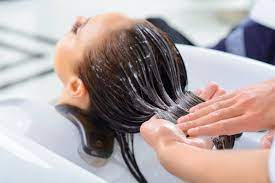Summer in Canada brings sunshine, outdoor activities, and unfortunately for many, excessively oily hair. The combination of heat, humidity, and increased sweat production can turn even normally balanced hair into an oil-slicked mess within hours. At Head Spa Toronto, we understand this seasonal struggle all too well, which is why we’ve developed specialized treatments and gathered expert advice to help you combat summer oiliness.
Why Does Hair Get Oilier in Summer?
Before diving into solutions, it’s essential to understand why your scalp produces more oil during the warmer months.
Summer’s higher temperatures naturally cause our bodies to sweat more, including our scalps. This excess moisture combines with the sebum (natural oil) your scalp produces, creating that heavy, greasy feeling. Additionally, many people find themselves more active in summer, increasing both sweat production and the frequency with which they touch their hair, further distributing oils throughout.
Environmental factors like humidity can also prevent moisture from evaporating properly from your scalp, leaving oils sitting on your hair rather than dissipating. Add in frequent swimming in chlorinated pools or salt water, and you’ve got the perfect recipe for scalp imbalance.
Professional Solutions at Head Spa Toronto
At Head Spa Toronto, we offer specialized treatments designed specifically to address summer oil control:
1. Detoxifying Scalp Treatment
Our signature treatment begins with a detailed scalp analysis to identify the root causes of your oiliness. We then apply a customized blend of clarifying products using our specialized microbubble technology, which creates bubbles 1/100th the size of a skin pore. These micro-bubbles penetrate deep into the hair follicles and pores, effectively removing excess sebum and odour from the scalp while maintaining essential moisture.
“The microbubble treatment is a game-changer for oily scalps,” explains our head therapist. “Unlike harsh stripping agents, it removes only excess oil while preserving the scalp’s natural balance.”
2. Japanese-Inspired Oil Control Therapy
Drawing from traditional Japanese head spa techniques, this treatment incorporates purifying clay masks and natural ingredients like rosemary and tea tree extracts that help regulate sebum production. The clay draws out impurities while botanical extracts balance your scalp’s oil production at the source.
3. Cooling Mint Refresh Treatment
This invigorating treatment is perfect for hot summer days, combining deep cleansing with refreshing mint extracts that reduce inflammation and control oil production. The cooling sensation provides immediate relief from heat-induced sweat and oil, while botanical actives work to normalize sebaceous gland activity.
Effective At-Home Solutions Between Appointments
While professional treatments provide the most comprehensive results, there are several effective practices you can incorporate at home:
1. Adjust Your Washing Routine
Contrary to what many believe, washing oily hair daily can actually worsen the problem. Overwashing strips the scalp of natural oils, triggering the sebaceous glands to produce even more sebum to compensate. Consider gradually extending the time between washes, allowing your scalp to regulate its oil production naturally.
When you do wash, use a gentle, sulfate-free clarifying shampoo designed for oily hair types, and focus the application on your scalp rather than your ends. Rinse thoroughly with cool water to help close the cuticles and reduce oil spread.
2. Try Natural Astringents
Several natural ingredients can help control excess oil:
- Apple cider vinegar rinse: Mix one part ACV with three parts water and use as a final rinse after shampooing to balance scalp pH and reduce oiliness.
- Green tea rinse: Brew strong green tea, allow it to cool, and use as a final rinse. The natural astringent properties help control oil production while antioxidants soothe the scalp.
- Witch hazel: Apply diluted witch hazel to your scalp before shampooing to help regulate oil and reduce inflammation.
3. Smart Styling Choices
Your styling routine can significantly impact oil distribution:
- Avoid touching your hair: Constantly running your fingers through your hair transfers oils from your hands and spreads scalp oils throughout your strands.
- Change your pillowcase regularly: Oils accumulate on your pillowcase and can be transferred back to your hair while you sleep.
- Brush strategically: Use a clean boar bristle brush to distribute oils from roots to ends, preventing concentration at the scalp. Clean your brush weekly to prevent oil buildup.
- Try dry shampoo preventatively: Apply a small amount of dry shampoo to your roots before oil appears—not just after your hair already looks greasy.
Nutritional Approaches to Balance Oily Hair
What you eat impacts your hair’s oil production. Consider these dietary adjustments:
- Reduce refined carbohydrates and sugars: These foods can trigger hormone fluctuations that increase oil production.
- Increase omega-3 fatty acids: Found in foods like salmon, walnuts, and flaxseeds, these healthy fats help regulate oil production from within.
- Stay hydrated: Proper hydration helps maintain overall body balance, including sebum production.
- Consider zinc-rich foods: Zinc helps regulate sebaceous gland activity. Include foods like pumpkin seeds, oysters, and chickpeas in your diet.
When to Book Your Next Head Spa Appointment
For optimal results during summer, we recommend booking a professional scalp treatment every 3-4 weeks. This frequency allows us to deeply cleanse and rebalance your scalp while monitoring changes and adjusting treatments accordingly.
Remember that everyone’s scalp is unique, and finding the right combination of professional treatments and at-home care may require some experimentation. Our therapists at Head Spa Toronto are trained to provide personalized recommendations based on your specific needs.
Don’t let oily hair dampen your summer spirit! Contact us today to schedule your consultation and take the first step toward balanced, fresh-feeling hair all season long.

